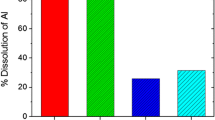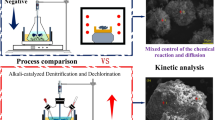Abstract
A hydrometallurgical process was developed for recycling pharmaceutical blisters. Leaching aluminum from pharmaceutical blisters using sodium hydroxide (NaOH) solutions was investigated with respect to leaching behaviors and kinetics. A L 9 (34) orthogonal design of experiments suggests that the most significant factor is NaOH concentration followed by temperature and leaching time. Factorial experiments demonstrate that the leaching rate of aluminum increases with increasing of the factors. The optimum conditions are temperature of 70 °C, leaching time of 20 min, NaOH concentration of 1.25 mol/L, liquid-to-solid mass ratio of 15:1 and agitation speed of 400 r/min. Under optimum conditions, the leaching rate is up to 100%, implying that aluminum and polyvinyl chloride (PVC) plastic in pharmaceutical blisters are separated completely. Kinetics of leaching aluminum is best described by the product layer diffusion control model, and the activation energy is calculated to be 19.26 kJ/mol.
Similar content being viewed by others
References
CUI Ji-rang, ZHANG Li-feng. Metallurgical recovery of metals from electronic waste: A review [J]. Journal of Hazardous Materials, 2008, 158(2): 228-256.
SHARHOLY M, AHMAD K, MAHMOOD G, TRIVEDI R C. Municipal solid waste management in Indian cities¡ªA review [J]. Waste Management, 2008, 28(2): 459-467.
KIM E Y, KIM M S, LEE J C, JEONG J, PANDEY B D. Leaching kinetics of copper from waste printed circuit boards by electrogenerated chlorine in HCl solution [J]. Hydrometallurgy, 2011, 107(3): 124-132.
YANG Jian-guang, WU Yong-tian, LI Jing. Recovery of ultrafine copper particles from metal components of waste printed circuit boards [J]. Hydrometallurgy, 2012, 121: 1-6.
JHA M K, KUMARI A, CHOUBEY P K, LEE J C, KUMAR V, JEONG J. Leaching of lead from solder material of waste printed circuit boards (PCBs) [J]. Hydrometallurgy, 2012, 121: 28-34.
SWAIN E. Industry outlook: pharmaceutical packaging [J]. Pharmaceutical and Medical Packaging News Magazine, 1998, 8: 10-13.
LEE B K, ELLENBECKER M J, MOURE E R. Analyses of the recycling potential of medical plastic wastes [J]. Waste Management, 2002, 22: 461-470.
VAN D A. PVC as pharmaceutical packaging material [J]. Pharmaceutisch Weekblad, 1991, 13: 109-118.
ALLEN D. Conducting a successful stability study for blister packaging [J]. Pharmaceutical and Medical Packaging News, 1999, 4: 24-30.
PARK C H, JEON H S, PARK J K. PVC removal from mixed plastics by triboelectrostatic separation [J]. Journal of Hazardous Materials, 2007, 144: 470-476.
ALI M F, SIDDIQUI M N. Thermal and catalytic decomposition behavior of PVC mixed plastic waste with petroleum residue [J]. Journal of Analytical and Applied Pyrolysis, 2005, 74: 282-289.
LUNGU M. Electrical separation of plastic materials using the triboelectric effect [J]. Minerals Engineering. 2004, 17: 69-75.
GENTE V, la MARCA F, LUCCI F, MASSACCI P. Electrical separation of plastics coming from special waste [J]. Waste Management, 2003, 23: 951-958.
GENTE V, LA M ARCA F, LUCCI F, MASSACCI P, PANI E. Cryo-comminution of plastic waste [J]. Waste Management, 2004, 24: 663-672.
ACHILIAS D S, GIANNOULIS A, PAPAGEORGIOU G Z. Recycling of polymers from plastic packaging materials using the dissolution-reprecipitation technique [J]. Polymer Bulletin, 2009, 63: 449-465.
YANG Zhen-hai, XU Ning, QIU Zhu-xian. Measurement of aluminum corrosive potential-pH and the polarization curve [J]. Journal of Northeastern University: Natural Science, 2000, 21: 401-403.
LEVENSPIEL O. Chemical reaction engineering [M]. New York: John & Wiley, 1972: 367-368.
ABALI Y, BAYCA S U, MISTINCIK E. Kinetics of oxalic acid leaching of tincal [J]. Chemical Engineering Journal, 2006, 123: 25-30.
LIU Zhi-hong, CAO Zhi-yan, LIU Zhi-yong, LI Qi-hou, LI Yu-hu. Leaching kinetics of willemite in (NH4)2SO4NH3H2O system at higher mass ratio of liquid to solid [J]. Journal of Central South University: Science and Technology, 2012, 43(2): 418-423. (in Chinese)
Author information
Authors and Affiliations
Corresponding author
Additional information
Foundation item: Project(2010CB630903) supported by the National Basic Research Program of China
Rights and permissions
About this article
Cite this article
Wang, Cq., Wang, H., Gu, Gh. et al. Kinetics and leaching behaviors of aluminum from pharmaceutical blisters in sodium hydroxide solution. J. Cent. South Univ. 22, 4545–4550 (2015). https://doi.org/10.1007/s11771-015-3004-x
Received:
Accepted:
Published:
Issue Date:
DOI: https://doi.org/10.1007/s11771-015-3004-x




